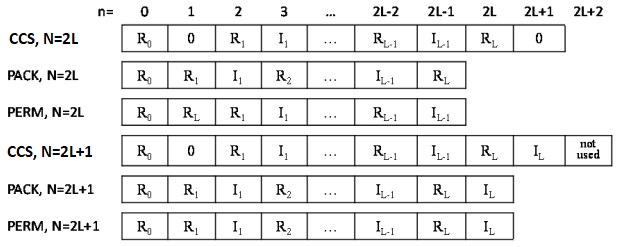Developer Reference for Intel® oneAPI Math Kernel Library for Fortran
A newer version of this document is available. Customers should click here to go to the newest version.
Visible to Intel only — GUID: GUID-F65C2255-963E-429F-9E74-99DFBCE1526F
Visible to Intel only — GUID: GUID-F65C2255-963E-429F-9E74-99DFBCE1526F
DFTI_PACKED_FORMAT
The result of the forward transform of real data is a conjugate-even sequence. Due to the symmetry property, only a part of the complex-valued sequence is stored in memory. The combination of the DFTI_PACKED_FORMAT and DFTI_CONJUGATE_EVEN_STORAGE configuration parameters defines how the conjugate-even sequence data is packed. If DFTI_CONJUGATE_EVEN_STORAGE is set to DFTI_COMPLEX_COMPLEX (default), the only possible value of DFTI_PACKED_FORMAT is DFTI_CCE_FORMAT; this association of configuration parameters is supported for transforms of any dimension. For a description of the corresponding packed format, see DFTI_CONJUGATE_EVEN_STORAGE. For one-dimensional transforms (only) with DFTI_CONJUGATE_EVEN_STORAGE set to DFTI_COMPLEX_REAL, the DFTI_PACKED_FORMAT configuration parameter must be DFTI_CCS_FORMAT, DFTI_PACK_FORMAT, or DFTI_PERM_FORMAT. The corresponding packed formats are explained and illustrated below.
DFTI_CCS_FORMAT for One-dimensional Transforms
The following figure illustrates the storage of a one-dimensional (1D) size-N conjugate-even sequence in a real array for the CCS, PACK, and PERM packed formats. The CCS format requires an array of size N+2, while the other formats require an array of size N. Zero-based indexing is used.

The real and imaginary parts of the complex-valued conjugate-even sequence Zk are located in a real-valued array AC as illustrated by figure "Storage of a 1D Size-N Conjugate-even Sequence in a Real Array" and can be used to reconstruct the whole conjugate-even sequence as follows:
real :: AR(N), AC(N+2)
...
status = DftiSetValue( desc, DFTI_PACKED_FORMAT, DFTI_CCS_FORMAT )
...
! on input: R{k} = AR(k)
status = DftiComputeForward( desc, AR, AC ) ! real-to-complex FFT
! on output:
! for k=1 … N/2+1: Z{k} = cmplx( AC(1 + (2*(k-1)+0)),
! AC(1 + (2*(k-1)+1)) )
! for k=N/2+2 … N: Z{k} = cmplx( AC(1 + (2*mod(N-k+1,N)+0)),
! -AC(1 + (2*mod(N-k+1,N)+1)))
DFTI_PACK_FORMAT for One-dimensional Transforms
The real and imaginary parts of the complex-valued conjugate-even sequence Zk are located in a real-valued array AC as illustrated by figure "Storage of a 1D Size-N Conjugate-even Sequence in a Real Array" and can be used to reconstruct the whole conjugate-even sequence as follows:
real :: AR(N), AC(N)
...
status = DftiSetValue( desc, DFTI_PACKED_FORMAT, DFTI_PACK_FORMAT )
...
! on input: R{k} = AR(k)
status = DftiComputeForward( desc, AR, AC ) ! real-to-complex FFT
! on output: Z{k} = cmplx( re, im ), where
! if (k == 1) then
! re = AC(1)
! im = 0
! else if (k-1 == N-k+1) then
! re = AC(2*(k-1))
! im = 0
! else if (k <= N/2+1) then
! re = AC(2*(k-1)+0)
! im = AC(2*(k-1)+1)
! else
! re = AC(2*(N-k+1)+0)
! im = -AC(2*(N-k+1)+1)
! end if
DFTI_PERM_FORMAT for One-dimensional Transforms
The real and imaginary parts of the complex-valued conjugate-even sequence Zk are located in real-valued array AC as illustrated by figure "Storage of a 1D Size-N Conjugate-even Sequence in a Real Array" and can be used to reconstruct the whole conjugate-even sequence as follows:
real :: AR(N), AC(N)
...
status = DftiSetValue( desc, DFTI_PACKED_FORMAT, DFTI_PERM_FORMAT )
...
! on input: R{k} = AR(k)
status = DftiComputeForward( desc, AR, AC ) ! real-to-complex FFT
! on output: Z{k} = cmplx( re, im ), where
! if (k == 1) then
! re = AC(1)
! im = 0
! else if (k-1 == N-k+1) then
! re = AC(2)
! im = 0
! else if (k <= N/2+1) then
! re = AC(1+2*(k-1)+0-mod(N,2))
! im = AC(1+2*(k-1)+1-mod(N,2))
! else
! re = AC(1+2*(N-k+1)+0-mod(N,2))
! im = -AC(1+2*(N-k+1)+1-mod(N,2))
! end if